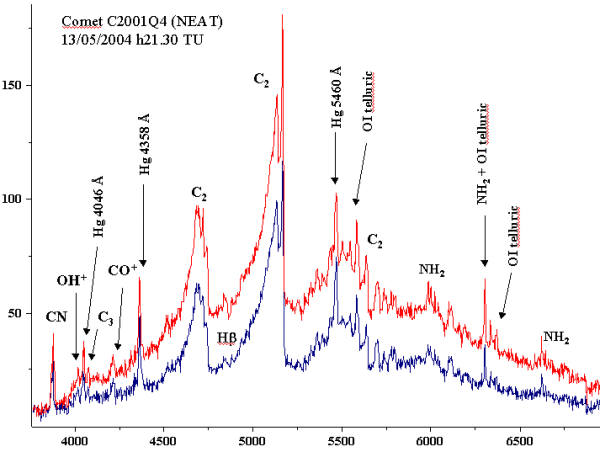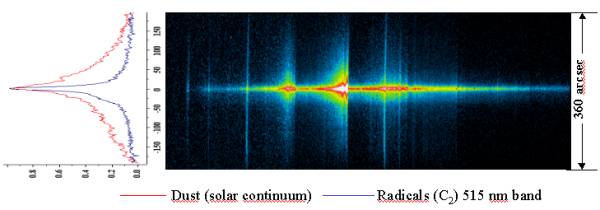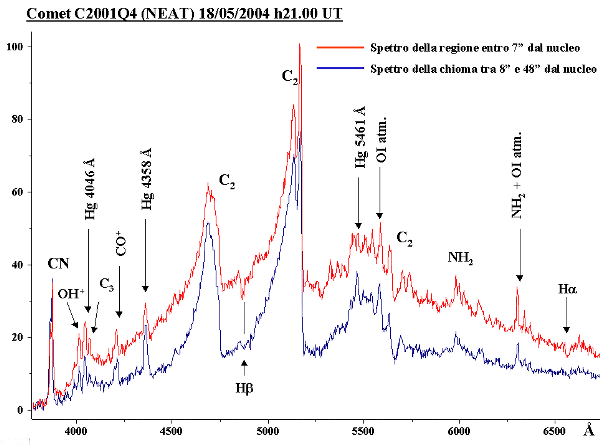THE SPECTRA OF COMETS
Introduction
- Linear 2000WM1
- 2001 Q4 (Neat)
- Macholz 2004Q2
Spectrum of comet 2001 Q4 (NEAT)
Observations of May 13th 2004
In the picture 1 is shown the spectrum of comet 2001 Q4 taken on May 13th 2004. Its distance from sun was 0.963 AU (very close to perihelion T=May 15.96) while the distance from earth was 0.4 AU.
Even if this comet was a 3th mag object, the spectrum is faint because only very few light of the comet can
enter the narrow slit of the spectrograph (3x360 arc sec). Moreover the weather was cloudy in the first
part of the evening so the spectrum was recorded with the comet quite low (15 deg) on the horizon.

|
Picture 1: Spectrum of comet C/2001 Q4 (NEAT) registered on 13.896 UT May 2004
with 10 min exposure for each one of the three spectral fields necessary to cover the
full 3800-6500 ┼ range with 2.6 ┼/pixel dispersion. Spectral resolution is about 3 pixels.
The telescope we used is a Cassegrain 0.6 m reflector at F/20 and the slit spans
360x3 arc seconds with the long size aligned with R.A.
The spectrograph is equipped with a f=300 collimating spherical mirror, a 600 lines/mm
grating and a 50 mm focusing lens camera. The CCD is an MX5 12 bit 512x290 camera.
The spectrum is not corrected for instrumental and atmospheric spectral response.
A sensitivity curve is available here .
The red spectrum is integrated from the nucleus up to a distance of 48 arcsec while the blue one was collected in the coma at a distance from 8 to 48 arcsec from the nucleus, thus avoiding the contribution of the central condensation. In this case the contribution of the solar spectrum reflected from dust is much lower.
|

|
Picture 2: CCD image of the spectrum in picture 1 that shows the spatial distribution of
dust and radicals. The presence of dust produces the reflected solar spectrum while radicals produce the fluorescence bands (East is up, the slit is oriented along RA).
Profile of continuum (and thus the amount of dust) is much peaked in the nuclear region while fluorescence extends much farther away
into the coma.
|
Observations of May 18th 2004
Finally sky was clear and without clouds. A new better spectrum of the comet was undertaken on May 18th from 20.30 UT to 21.30 UT. Distance from sun was 0.964 AU while distance from earth was 0.5 AU. The comet can be seen with naked eye as a 4th mag little nebula. At the telescope it showed much lower condensation than on may 13th.

|
Picture 3: CCD image of the spectrum in picture 4 that shows the image of the inner part of the coma throught the entrance slit of the spectrograph wide opened (East is up, the slit is oriented along RA). The spectrum is represented with colours added artificially to the CCD gray scale image. The presence of dust produces the reflected solar spectrum (continuum stripe in the middle of the spectrum) while radicals produce the fluorescence bands.
Profile of continuum (and thus the amount of dust) is much peaked in the nuclear region while fluorescence extends much farther away into the coma.
Despite to the slit that was closed to 3 arcsec during spectrum exposition (15 min for each one of the 3 spectral windows that are necessary to cover the full 3700-7000 A range), faint lines due to Hg street lamps can be seen in the spectrum together with comet bands.
|

|
Picture 4: Spectra of the comet extracted from the CCD image of picture 3. The red spectrum was integrated in the inner part of the coma, within 7 arcsec from nucleus while the blue spectrum was integrated from 8 to 47 arc sec from the central condensation and shows a much lower contribution of solar spectrum reflected by dust. Tentative attribution of the bands is indicated.
|
Further treatments and refinements of the spectra will be posted in this page on next days.
Go to introduction or other comets spectra:
Introduction
- 2000 WM
- Macholz 2004Q2
|




